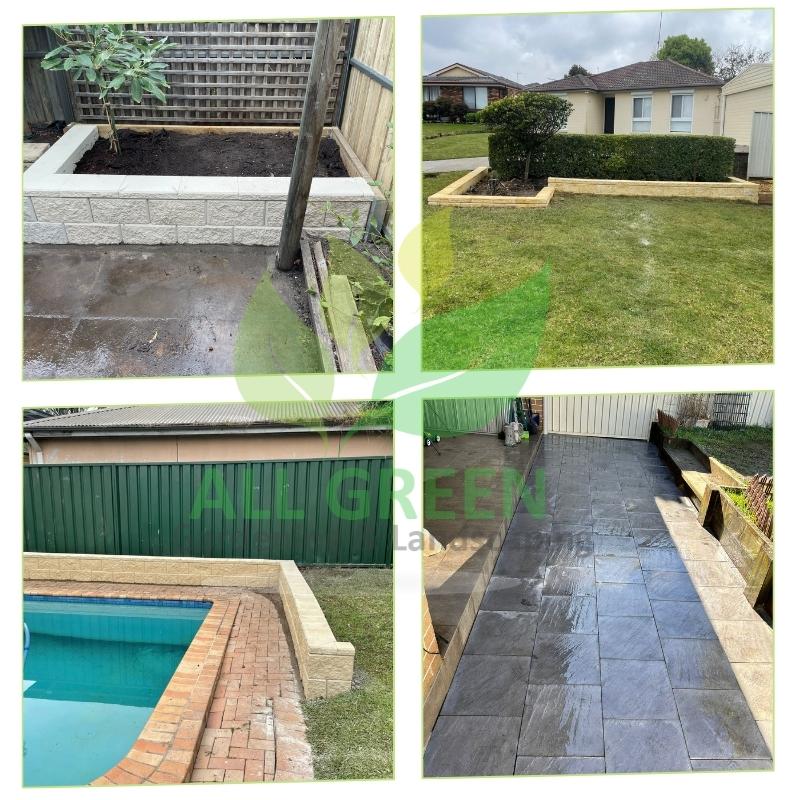Quick and Hassle-Free Landscaping Mount Vernon Services. Moreover, time is of the essence. Realise your dream yard without unnecessary delays with All Green Gardening Services. In short, we deliver fast and reliable landscaping solutions. Promptly call us and start your project today.

Looking for a Local Landscaper in Mount Vernon? 🌱
The common search term for finding a local landscaper is “landscaper near me”. Here’s who we are! We cater to landscape garden maintenance needs, from retaining walls to outdoor space and garden design, and complete landscaping projects.
Mount Vernon’s Best Landscaping Company Is Here
We offer both affordability and excellence in landscape design services, regardless of project size. Structural landscaping expertise defines our team’s complete solution.
We’re your local choice, committed to affordability and backed by our Best Price Guarantee!
All Green Gardening & Landscaping is NSW’s beacon for landscaping perfection. From weeding to paving, we sculpt spaces that captivate and add value. A radiant garden awaits you. Partner with us and let your exteriors speak volumes.
We also serve and have landscaping projects in the following surrounding suburbs:
Why Opt for All Green Gardening & Landscaping?
- All-Round Expertise: Be it paving, mulching, tree removal, or turf laying, our wide range of services caters to every gardening need.
- Property Enhancement: Boost your property’s appeal and worth with our outstanding landscaping solutions.
- Tailored to You: We offer bespoke landscaping solutions to align with your garden’s individual characteristics.
- Sustainable Approach: Our name embodies our commitment to eco-friendly and sustainable landscaping practices.
- Skilled Team: Benefit from our seasoned professionals, known for their excellence in landscaping.
- Client First: We value our customers, ensuring timely project delivery and transparent interactions.
Mount Vernon Landscaping Services by All Green Gardening & Landscaping
All Green Gardening and Landscaping is renowned for its talent in constructing captivating, organic landscapes that enrich the appeal of residential and commercial properties through careful landscape design. Stay connected with us through our Facebook Page. Whether it’s backyard landscaping Mount Vernon or a larger project, we strive to give the best customer service & outcomes through our professional landscaping Mount Vernon service. In the realm of landscaping, we excel in both residential and commercial sectors, teaming up with our experienced designers and installers.
Trust our licensed landscape designers for superior designs on your extensive projects. We begin with a site consultation. Our designers will sit down with you to understand your project and the necessary work. After completing this step, we’ll furnish you with a comprehensive landscape design consultation.
Why Trust All Green Gardening & Landscaping? ⭐
For over a decade, our expert team has been beautifying landscapes in your vicinity. Our gardening and landscaping services come with a 100% Satisfaction Guarantee, ensuring your contentment with our work every time.
The services provided here by experienced Landscapers are so remarkable that whenever our clients think about Best Landscaper Nearby. It is always going to be our name popping in their mind.
Our Services
Best Turf Laying Solutions in Mount Vernon
Enhance Leisure Spaces with Turf Laying Services in Mount Vernon. Furthermore, a well-laid turf can turn any outdoor space into a recreational area. Whether it’s for picnics or play, a grassy area enhances your quality of life. All Green Gardening Services ensures you get that luxury. Reach out today and upgrade your outdoor living.
Top-Quality Mulching Services: Best in Mount Vernon, NSW
All Green Gardening & Landscaping brings toMount Vernon, NSW 2178 mulching services that breathe life into gardens. We focus on moisture retention, weed reduction, and soil enrichment, guaranteeing gardens that exude health and charm. Choose us for unparalleled gardening prowess.
Our Paving Mount Vernon Experts
If you’re looking to buy high-quality pavers in Mount Vernon, look no further than All Green Gardening and Landscaping!
Need a Retaining Walls Mount Vernon Team
In Mount Vernon, we emphasize offering excellent panel and post concrete retaining walls, a cost-effective alternative to brick and limestone.
Expert Tree Services inMount Vernon
For comprehensive tree care inMount Vernon, look no further than All Green Gardening & Landscaping. Our dedicated team provides services from pruning to safe tree removals. Prioritize your tree’s health and safety with us by your side.
Top-Tier Weeding Services in Mount Vernon
Keep your garden flourishing with All Green Gardening & Landscaping’s exceptional weeding services. Serving Mount Vernon, our experts remove and prevent unwanted growth, ensuring your plants remain undisturbed. Choose us for gardens that radiate health and beauty.
Affordable Landscaping Services in Mount Vernon NSW 2178
Frequently Asked Questions
{We offer a comprehensive range of landscaping services, including garden design, lawn maintenance, tree and shrub care, hardscape construction, irrigation system installation, and more. | Our landscaping services encompass garden design, lawn upkeep, tree and shrub care, hardscape construction, irrigation system installation, and much more.
Our landscaping services are tailored to elevate your property’s visual appeal, resulting in captivating outdoor spaces that boost curb appeal and property value.
Our strength lies in tailoring landscaping solutions to your specific tastes, making your outdoor space uniquely yours.
Current Landscaping Jobs in Mount Vernon
We are currently looking for a Local Landscaper in Mount Vernon who has the right experience and can attend to jobs on the same day.
[justified_image_grid row_height=800 height_deviation=0 overlay=off use_timthumb=no disable_cropping=yes flickr_search_text=Mount Vernon-NSW max_rows=4 flickr_search_sort=popular]

